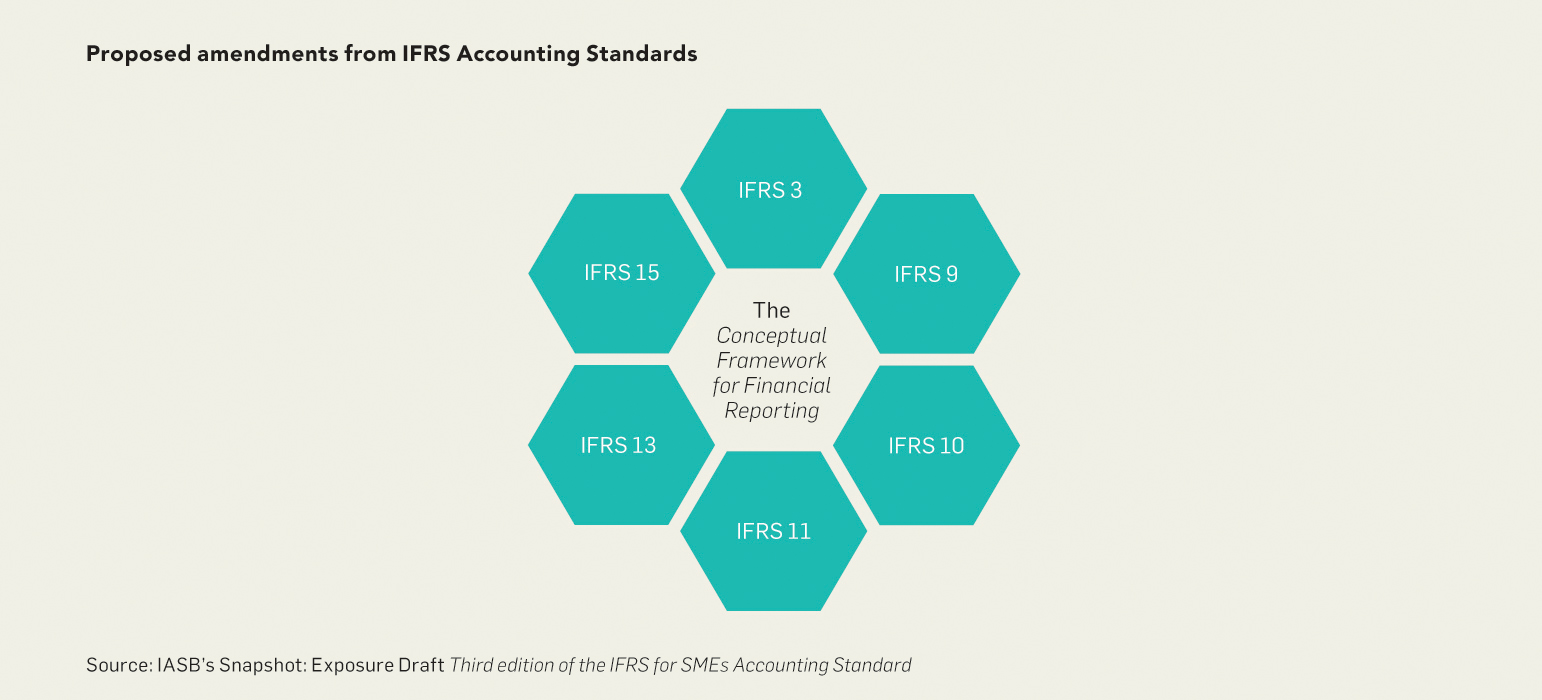In September 2022, the International Accounting Standards Board (IASB) published an exposure draft (ED) to propose amendments to the International Financial Reporting Standard for Small and Medium-sized Entities (IFRS for SMEs) Accounting Standard. The objective of the ED is to update the IFRS for SMEs Accounting Standard to reflect improvements that have been made in full IFRS Accounting Standards while keeping the standard simple for SMEs.
The IASB is proposing amendments to the equivalent sections of the IFRS for SMEs Accounting Standard for the IFRS Accounting Standards set out in the diagram below. The proposals reflect stakeholders’ feedback on the Request for Information published in 2020 as part of its Second Comprehensive Review of the IFRS for SMEs Accounting Standard and the advice from the IASB’s SME Implementation Group.
The IASB had considered IFRS 16 Leases but did not propose any amendments to this topic in the IFRS for SMEs Accounting Standard. The IASB considered that aligning the standard with IFRS 16 at this time may impose workload on SMEs disproportionate to the benefit to users of their financial statements, and it is more appropriate to consider such alignment after the post-implementation review of IFRS 16.
The Institute’s Standard Setting Department responded to the ED in February this year. The Institute’s submission is available on its website.
In Hong Kong, the majority of the SMEs either prepare their financial statements under the Institute’s home-grown Small and Medium-sized Entity Financial Reporting Framework and Financial Reporting Standard or full Hong Kong Financial Reporting Standards (HKFRS) Standards. The extent of application of the HKFRS for Private Entities (i.e. the local version of IFRS for SMEs Accounting Standard) is relatively limited in Hong Kong. Considering the limited use of the HKFRS for Private Entities in Hong Kong, we primarily commented on the following proposals in the ED. This article summarizes our major comments on the ED.
Impairment of financial assets
Our respondents expressed concern about the proposed application of the expected credit loss (ECL) model on financial assets measured at amortized cost (other than trade receivables and contract assets). In Hong Kong, non-trade related receivables from related parties and business partners are common among SMEs and our respondents anticipated that SMEs would encounter the following practical difficulties when applying the ECL model to these receivables:
a) Non-trade receivables from related parties and business partners are often one-off in nature. Most SMEs do not possess sufficient historical data, such as credit-loss experience, either internally or from its peer group for comparable financial instruments to ascertain the appropriate credit loss rates.
b) The ECL model requires the use of forward-looking information and an estimate of probability and related weighting for formulating multiple forward-looking scenarios. Since SMEs usually have limited resources and expertise, our respondents expressed concern about the practical challenges in identifying and obtaining relevant forward-looking information that is reasonable and supportable for measuring ECL of these receivables.
In view of these challenges, our respondents questioned the quality of impairment information that would be provided by SMEs using the ECL model and whether the accounting outcome would faithfully represent the likelihood of the collection of future cash flows of those non-trade receivables at the reporting date.
Furthermore, SMEs in Hong Kong are usually owner-managed businesses with a limited number of users of their financial statements. Users of SMEs’ financial statements generally do not have a strong demand for the more sophisticated information provided under the ECL model on non-trade receivables. In addition, considering the complexity and difficulties for SMEs to apply the ECL model properly, it is doubtful whether the users of SMEs’ financial statements would regard the ECL information as truly reliable.
Lastly, the proposals introduce two impairment models for financial assets measured at amortized cost – incurred loss model for trade receivable and contract assets, and the ECL model for all other receivables. We see little merit in having two impairment models for financial assets measured at amortized cost as it would add complexity, create confusion and not meet the principle of simplicity.
In light of the above, we consider that the ECL model would impose undue cost or effort on SMEs and may not significantly improve the usefulness of information about impairment of financial assets held by SMEs. Taking into account the costs and benefits of the proposals, we recommend the IASB retain the incurred loss model for all financial assets measured at amortized cost.
If the IASB were to go ahead with its proposals, we suggested that the IASB:
a) Provide guidance or examples on the practical expedients that SMEs can apply in measuring ECL; and
b) Clarify the considerations for SMEs in assessing the “undue cost or effort” concept in terms of obtaining reasonable and supportable information for measuring ECL, given the model would be more costly for SMEs (as compared to large private or listed entities) to apply.
Revenue from contracts with customers
We generally supported the proposals in the revised section on revenue and considered that they are appropriate for SMEs and users of their financial statements. Nevertheless, we have the following comments and recommendations:
a) Certain proposed simplified requirements of IFRS 15 Revenue from Contracts with Customers, for example warranty, involve the evaluation of whether the financial impact of the warranty is “significant to the contract” in order to determine the accounting treatment. Such a requirement does not exist in IFRS 15. To ensure consistent application of the requirement by the SMEs, we recommended that the IASB provide guidance or examples to illustrate how the “significant” concept should be applied in those cases.
b) In order to make the proposed requirements simpler for SMEs to apply, the ED has reframed the principles in IFRS 15 for principal versus agent and the criteria for revenue recognition over time. For the principal versus agent considerations, IFRS 15 stipulates an overarching principle which is supported by three indicators. The ED takes a different approach by listing three criteria (one of which is the overarching principle in IFRS 15) and indicates that an entity would be a principal if any one of the three criteria is met. Also, the criteria for revenue recognition over time has changed from three criteria in IFRS 15 to four criteria in the ED. While we on the whole agree with the IASB’s simplification approach, we are concerned that the simplifications made on these two areas may unintentionally result in different accounting outcomes from full IFRS Accounting Standards in certain situations. Accordingly, we recommended the IASB clarify whether the principles and requirements on these two areas are the same under the ED and IFRS 15 to avoid confusion.
Next steps
The IASB will start to deliberate the comments received on the ED in the second quarter of this year and will decide whether to proceed with the proposed amendments to the IFRS for SMEs Accounting Standard. Stay tuned for the development of the standard.
This article was contributed by Kennis Lee and George Au, Associate Directors of the Institute’s Standard Setting Department. Visit our “What’s new” webpage for our latest publications, and follow us on LinkedIn for upcoming activities.
















